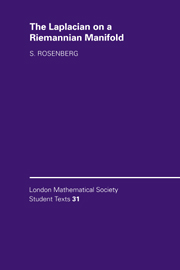4 - The Heat Equation Approach to the Atiyah-Singer Index Theorem
Published online by Cambridge University Press: 24 December 2009
Summary
The Atiyah-Singer index theorem is a deep generalization of the classical Gauss- Bonnet theorem, including as special cases the Chern-Gauss-Bonnet theorem, the Hirzebruch signature theorem, and the Hirzebruch-Riemann-Roch theorem. Although the index theorem is about 35 years old at this point, it continues to have new applications in areas as apparently diverse as number theory and mathematical physics. The index theorem and its various generalizations (families index theorem, K-theoretic versions, etc.) admit many interpretations. We will choose the point of view that the index theorem expresses topological quantities in terms of geometric ones, just as in the Gauss-Bonnet theorem. This viewpoint leads to a heat equation proof of the index theorem, suggested by McKean and Singer [43] in the late 1960s and established by Gilkey [29], Patodi [55, 56], and Atiyah, Bott and Patodi [1] in the early 1970s. The heat equation method has since been refined by Getzler [28] (cf. [5]).
In this chapter, we will give a complete heat equation proof for the Chern- Gauss-Bonnet theorem, and state without proof the Hirzebruch signature theorem, the Hirzebruch-Riemann-Roch theorem, and the Atiyah-Singer index theorem. Complete proofs can be found in [5] and [30]. We have also included a short introduction to characteristic classes.
The Chern-Gauss Bonnet Theorem
The key ideas in the heat equation method are (i) by Chapter 1, the long time behavior of the heat operator for the Laplacian on forms is controlled by the topology of the manifold in the form of the de Rham cohomology, (ii) the short time behavior is controlled by the geometry of the asymptotic expansion, as explained in Chapter 3, and (iii) certain combinations of heat operators will have time independent behavior.
- Type
- Chapter
- Information
- The Laplacian on a Riemannian ManifoldAn Introduction to Analysis on Manifolds, pp. 111 - 143Publisher: Cambridge University PressPrint publication year: 1997



